oil change Lancia Voyager 2014 Owner handbook (in English)
[x] Cancel search | Manufacturer: LANCIA, Model Year: 2014, Model line: Voyager, Model: Lancia Voyager 2014Pages: 364, PDF Size: 3.49 MB
Page 316 of 364

Engine Air Cleaner Filter
Selection
The quality of replacement engine air
cleaner filters varies considerably.
Only high quality filters should be
used to assure most efficient service.
LANCIA engine air cleaner filters are
a high quality filter and are recom-
mended.
INTERVENTION
REGENERATION
STRATEGY – 2.8L DIESEL
ENGINE
This vehicle is equipped with a state-
of-the-art engine and exhaust system
containing a diesel particulate filter.
The engine and exhaust after-
treatment system work together to
meet the Emission standards. The
system manages engine combustion to
allow the exhaust system’s catalyst to
trap and burn Particulate Matter
(PM) pollutants with no input or in-
teraction on your part.Refer to “Electronic Vehicle Informa-
tion Center (EVIC)” in “Understand-
ing Your Instrument Panel” for fur-
ther information.
EXHAUST SYSTEM
The best protection against carbon
monoxide entry into the vehicle body
is a properly maintained engine ex-
haust system.
Whenever a change is noticed in the
sound of the exhaust system, when
exhaust fumes can be detected inside
the vehicle, or when the underside or
rear of the vehicle is damaged, have a
competent mechanic inspect the com-
plete exhaust system and adjacent
body areas for broken, damaged, de-
teriorated, or mispositioned parts.
Open seams or loose connections
could permit exhaust fumes to seep
into the passenger compartment. In
addition, have the exhaust system in-
spected each time the vehicle is raised
for lubrication or oil change. Replace
as required.
WARNING!
Exhaust gases can injure or kill.
They contain carbon monoxide
(CO), which is colorless and odor-
less. Breathing it can make you un-
conscious and can eventually poi-
son you. To avoid breathing CO,
refer to “Safety Tips/Exhaust Gas”
in “Things To Know Before Start-
ing Your Vehicle” for further infor-
mation.
CAUTION!
The catalytic converter requires the
use of unleaded fuel only. Leaded
gasoline will destroy the effective-
ness of the catalyst as an emissions
control device and may seriously
reduce engine performance and
cause serious damage to the engine.
Under normal operating conditions,
the catalytic converter will not require
maintenance. However, it is impor-
tant to keep the engine properly tuned
to assure proper catalyst operation
and prevent possible catalyst damage.
310
Page 337 of 364

CAUTION!
Where possible, it is advisable to
have bulbs changed at a LANCIA
Dealership. Proper operation and
orientation of the external lights are
essential for driving safety and
complying with the law.
HIGH INTENSITY
DISCHARGE HEADLAMPS
(HID) (for versions/markets,
where provided)
The headlamps are a type of high
voltage discharge tube. High voltage
can remain in the circuit even with the
headlamp switch off and the key re-
moved.Because of this, you should
not attempt to service a headlamp
bulb yourself. If a headlamp bulb
fails, take your vehicle to an au-
thorized dealer for service.
WARNING!
A transient high voltage occurs at
the bulb sockets of High Intensity
Discharge (HID) headlamps when
the headlamp switch is turned ON.
It may cause serious electrical
shock or electrocution if not ser-
viced properly. See your authorized
dealer for service.
NOTE: On vehicles equipped
with High Intensity Discharge
(HID) headlamps, when the head-
lamps are turned on, there is a
blue hue to the lamps. This dimin-
ishes and becomes more white af-
ter approximately 10 seconds, as
the system charges.
QUAD HEADLAMPS (for
versions/markets, where
provided)
1. Raise the hood to access the high
or low beam bulbs at the rear of the
headlamp housing.
2. Release the two tabs on the side of
the connector and remove the connec-
tor from the bulb. 3. Twist the headlamp bulb and pull
the bulb from the headlamp housing.
4. Install the new headlamp bulb and
twist until locked into the headlamp
housing.
CAUTION!
Do not touch the new bulb with
your fingers. Oil contamination will
severely shorten bulb life. If the
bulb comes in contact with an oily
surface, clean the bulb with rub-
bing alcohol.
5. Reconnect the wiring connector to
the bulb.
FRONT TURN SIGNAL AND
SIDE MARKER LAMPS
Access to change the turn signal or
side marker bulb is from the rear of
the headlamp housing.
1. Twist the turn signal or side
marker socket to remove the socket.
2. Pull bulb from the socket.
3. Replace the bulb and reinstall
socket. 331
Page 346 of 364
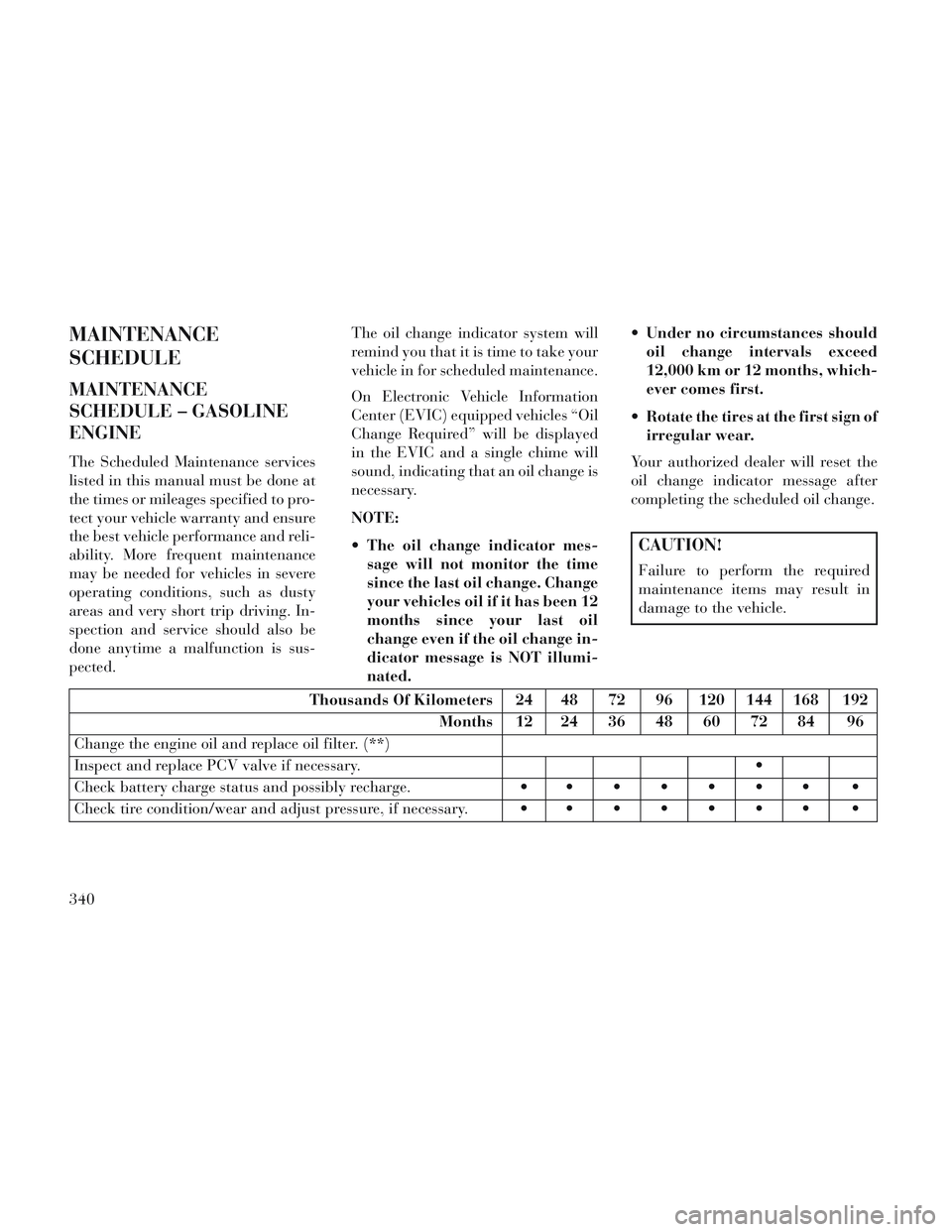
MAINTENANCE
SCHEDULE
MAINTENANCE
SCHEDULE – GASOLINE
ENGINE
The Scheduled Maintenance services
listed in this manual must be done at
the times or mileages specified to pro-
tect your vehicle warranty and ensure
the best vehicle performance and reli-
ability. More frequent maintenance
may be needed for vehicles in severe
operating conditions, such as dusty
areas and very short trip driving. In-
spection and service should also be
done anytime a malfunction is sus-
pected.The oil change indicator system will
remind you that it is time to take your
vehicle in for scheduled maintenance.
On Electronic Vehicle Information
Center (EVIC) equipped vehicles “Oil
Change Required” will be displayed
in the EVIC and a single chime will
sound, indicating that an oil change is
necessary.
NOTE:
The oil change indicator mes-
sage will not monitor the time
since the last oil change. Change
your vehicles oil if it has been 12
months since your last oil
change even if the oil change in-
dicator message is NOT illumi-
nated. Under no circumstances should
oil change intervals exceed
12,000 km or 12 months, which-
ever comes first.
Rotate the tires at the first sign of irregular wear.
Your authorized dealer will reset the
oil change indicator message after
completing the scheduled oil change.
CAUTION!
Failure to perform the required
maintenance items may result in
damage to the vehicle.
Thousands Of Kilometers 24 48 72 96 120 144 168 192 Months 12 24 36 48 60 72 84 96
Change the engine oil and replace oil filter. (**)
Inspect and replace PCV valve if necessary.
Check battery charge status and possibly recharge.
Check tire condition/wear and adjust pressure, if necessary.
340
Page 348 of 364
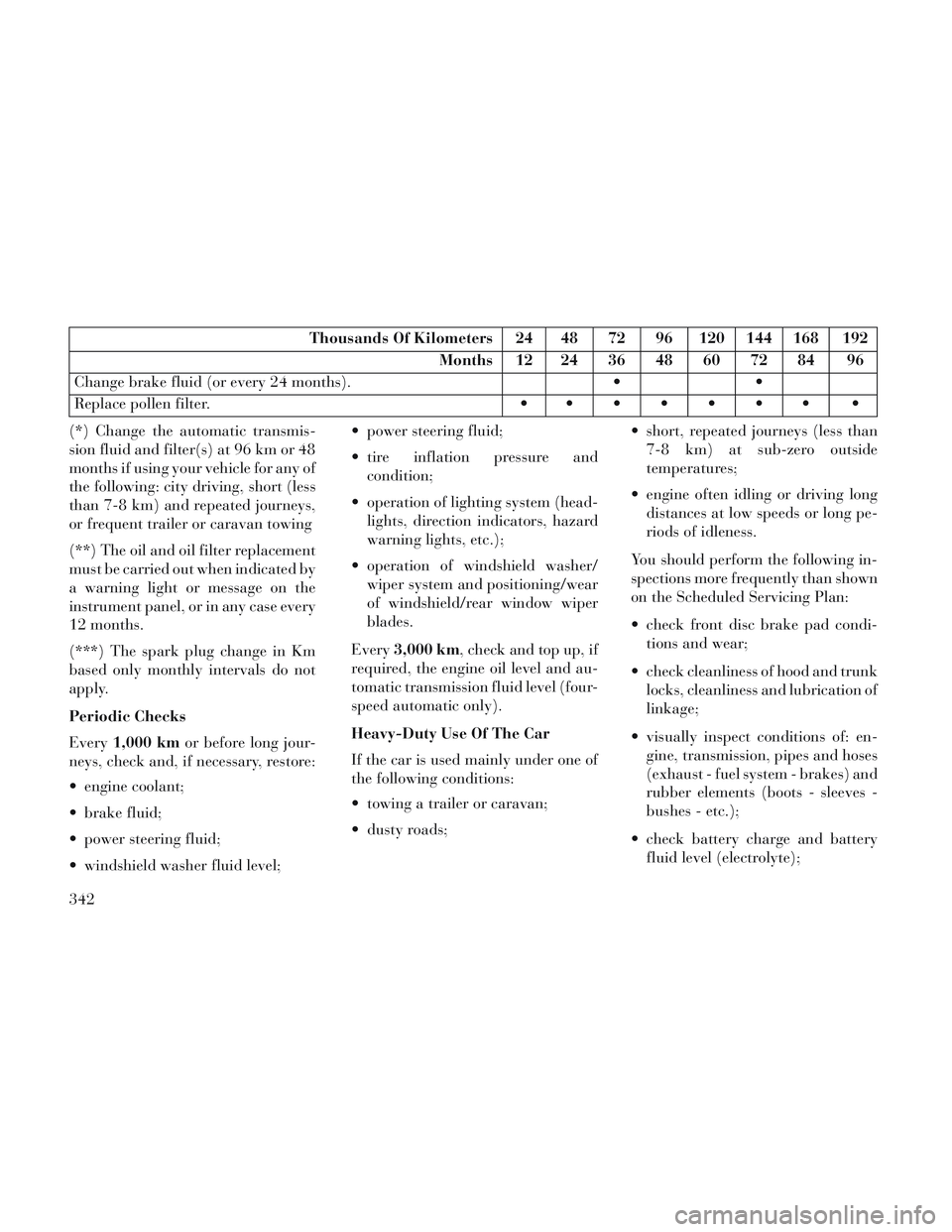
Thousands Of Kilometers 24 48 72 96 120 144 168 192Months 12 24 36 48 60 72 84 96
Change brake fluid (or every 24 months).
Replace pollen filter.
(*) Change the automatic transmis-
sion fluid and filter(s) at 96 km or 48
months if using your vehicle for any of
the following: city driving, short (less
than 7-8 km) and repeated journeys,
or frequent trailer or caravan towing
(**) The oil and oil filter replacement
must be carried out when indicated by
a warning light or message on the
instrument panel, or in any case every
12 months.
(***) The spark plug change in Km
based only monthly intervals do not
apply.
Periodic Checks
Every 1,000 km or before long jour-
neys, check and, if necessary, restore:
engine coolant;
brake fluid;
power steering fluid;
windshield washer fluid level; power steering fluid;
tire inflation pressure and
condition;
operation of lighting system (head- lights, direction indicators, hazard
warning lights, etc.);
operation of windshield washer/ wiper system and positioning/wear
of windshield/rear window wiper
blades.
Every 3,000 km, check and top up, if
required, the engine oil level and au-
tomatic transmission fluid level (four-
speed automatic only).
Heavy-Duty Use Of The Car
If the car is used mainly under one of
the following conditions:
towing a trailer or caravan;
dusty roads; short, repeated journeys (less than
7-8 km) at sub-zero outside
temperatures;
engine often idling or driving long distances at low speeds or long pe-
riods of idleness.
You should perform the following in-
spections more frequently than shown
on the Scheduled Servicing Plan:
check front disc brake pad condi- tions and wear;
check cleanliness of hood and trunk locks, cleanliness and lubrication of
linkage;
visually inspect conditions of: en- gine, transmission, pipes and hoses
(exhaust - fuel system - brakes) and
rubber elements (boots - sleeves -
bushes - etc.);
check battery charge and battery fluid level (electrolyte);
342
Page 349 of 364
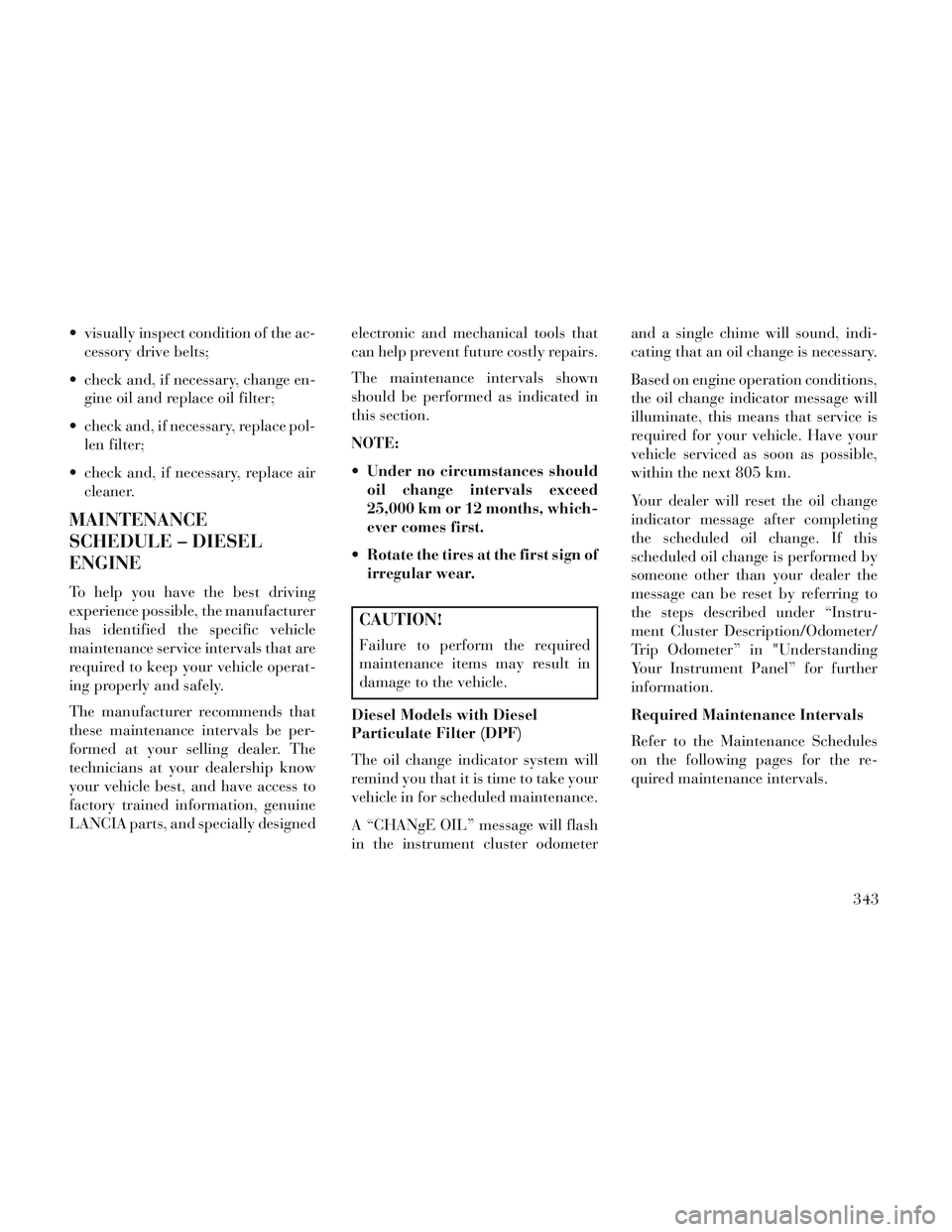
visually inspect condition of the ac-cessory drive belts;
check and, if necessary, change en- gine oil and replace oil filter;
check and, if necessary, replace pol- len filter;
check and, if necessary, replace air cleaner.
MAINTENANCE
SCHEDULE – DIESEL
ENGINE
To help you have the best driving
experience possible, the manufacturer
has identified the specific vehicle
maintenance service intervals that are
required to keep your vehicle operat-
ing properly and safely.
The manufacturer recommends that
these maintenance intervals be per-
formed at your selling dealer. The
technicians at your dealership know
your vehicle best, and have access to
factory trained information, genuine
LANCIA parts, and specially designed electronic and mechanical tools that
can help prevent future costly repairs.
The maintenance intervals shown
should be performed as indicated in
this section.
NOTE:
Under no circumstances should
oil change intervals exceed
25,000 km or 12 months, which-
ever comes first.
Rotate the tires at the first sign of irregular wear.
CAUTION!
Failure to perform the required
maintenance items may result in
damage to the vehicle.
Diesel Models with Diesel
Particulate Filter (DPF)
The oil change indicator system will
remind you that it is time to take your
vehicle in for scheduled maintenance.
A “CHANgE OIL” message will flash
in the instrument cluster odometer and a single chime will sound, indi-
cating that an oil change is necessary.
Based on engine operation conditions,
the oil change indicator message will
illuminate, this means that service is
required for your vehicle. Have your
vehicle serviced as soon as possible,
within the next 805 km.
Your dealer will reset the oil change
indicator message after completing
the scheduled oil change. If this
scheduled oil change is performed by
someone other than your dealer the
message can be reset by referring to
the steps described under “Instru-
ment Cluster Description/Odometer/
Trip Odometer” in "Understanding
Your Instrument Panel” for further
information.
Required Maintenance Intervals
Refer to the Maintenance Schedules
on the following pages for the re-
quired maintenance intervals.
343
Page 350 of 364

Thousands Of Kilometers 20 40 60 80 100 120 140 160 180 200Months 12 24 36 48 60 72 84 96 108 120
Change engine oil and replace oil filter. (**)
Rotate Tires.
Check battery charge status and possibly re-
charge.
Check tire condition/wear and adjust pressure, if
necessary.
Check operation of lighting system (headlamps,
direction indicators, hazard warning lights, lug-
gage compartment, passenger compartment, glove
compartment, instrument panel warning lights,
etc.).
Check operation of windscreen washer system
and adjust jets if necessary.
Check windshield/rear window wiper blade
position/wear.
Check cleanliness of hood and tailgate locks and
cleanliness and lubrication of linkages.
Visually inspect condition of: exterior bodywork,
underbody protection, pipes and hoses (exhaust -
fuel system - brakes), rubber elements (boots,
sleeves, bushes, etc.).
Check conditions and wear of front disc brake pads.
Check conditions and wear of rear disc brake pads.
344
Page 351 of 364

Thousands Of Kilometers 20 40 60 80 100 120 140 160 180 200Months 12 24 36 48 60 72 84 96 108 120
Check and, if necessary, top up fluid levels
(brakes, windshield washer, battery, engine cool-
ant, etc.).
Visually inspect the condition of accessory drive
belt/s.
Check toothed timing drive belt conditions.
Check exhaust gas emissions.
Check engine management system operation (via
diagnostic socket).
Adjust parking brake shoes as necessary.
Change the automatic transmission fluid and fil-
ter (***).
Replace fuel filter (diesel version).
Replace accessory drive belt/s.
Replace toothed timing drive belt (*).
Replace air filter cartridge.
Change brake fluid (or every 24 months).
Replace pollen filter.
(*) Regardless of the distance cov-
ered, the timing belt must be changed
every 4 years for particularly de-
manding use (cold climates, city driv-
ing, long periods of idling) or at least
every 5 years. (**) The oil and oil filter replacement
must be carried out when indicated by
a warning light or message on the
instrument panel, or in any case every
12 months.
(***)
Change the automatic transmis-
sion fluid and filter(s) at 100 km or
60 months if using your vehicle for any
of the following: city driving, short (less
than 7-8 km) and repeated journeys, or
frequent trailer or caravan towing.
345
Page 352 of 364

Periodic Checks
Every1,000 km or before long jour-
neys, check and, if necessary, restore:
engine coolant;
brake fluid;
power steering fluid;
windshield washer fluid level;
power steering fluid;
tire inflation pressure and condition;
operation of lighting system (head- lights, direction indicators, hazard
warning lights, etc.);
operation of windshield washer/ wiper system and positioning/wear
of windshield/rear window wiper
blades.
Every 3,000 km, check and top up, if
required, the engine oil level and au-
tomatic transmission fluid level (four-
speed automatic only). Heavy-Duty Use Of The Car
If the car is used mainly under one of
the following conditions:
towing a trailer or caravan;
dusty roads;
short, repeated journeys (less than
7-8 km) at sub-zero outside
temperatures;
engine often idling or driving long distances at low speeds or long pe-
riods of idleness.
You should perform the following in-
spections more frequently than shown
on the Scheduled Servicing Plan:
check front disc brake pad condi- tions and wear;
check cleanliness of hood and trunk locks, cleanliness and lubrication of
linkage; visually inspect conditions of: en-
gine, transmission, pipes and hoses
(exhaust - fuel system - brakes) and
rubber elements (boots - sleeves -
bushes - etc.);
check battery charge and battery fluid level (electrolyte);
visually inspect condition of the ac- cessory drive belts;
check and, if necessary, change en- gine oil and replace oil filter;
check and, if necessary, replace pol- len filter;
check and, if necessary, replace air cleaner.
346
Page 354 of 364
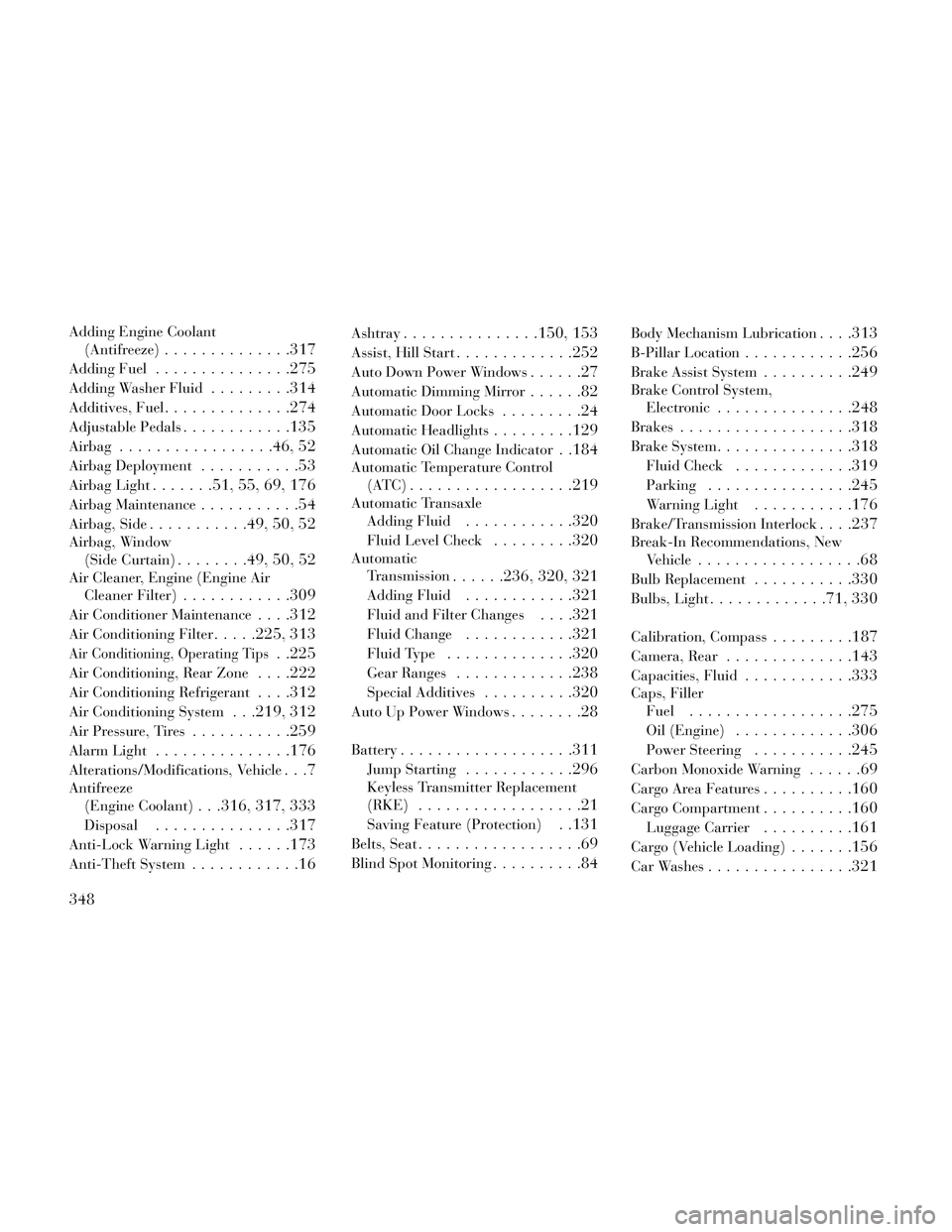
Adding Engine Coolant(Antifreeze)
............. .317
Adding Fuel.............. .275
Adding Washer Fluid.........314
Additives, Fuel..............274
Adjustable Pedals............135
Airbag.................46, 52
Airbag Deployment...........53
Airbag Light.......51, 55, 69, 176
Airbag Maintenance...........54
Airbag, Side...........49, 50, 52
Airbag, Window
(Side Curtain)
........49, 50, 52
Air Cleaner, Engine (Engine AirCleaner Filter)
............309
Air Conditioner Maintenance. . . .312
Air Conditioning Filter.....225, 313
Air Conditioning, Operating Tips. .225
Air Conditioning, Rear Zone. . . .222
Air Conditioning Refrigerant. . . .312
Air Conditioning System. . .219, 312
Air Pressure, Tires...........259
Alarm Light.............. .176
Alterations/Modifications, Vehicle...7
Antifreeze
(Engine Coolant)
. . .316, 317, 333
Disposal.............. .317
Anti-Lock Warning Light......173
Anti-Theft System............16
Ashtray...............150, 153
Assist, Hill Start.............252
Auto Down Power Windows......27
Automatic Dimming Mirror......82
Automatic Door Locks.........24
Automatic Headlights.........129
Automatic Oil Change Indicator. .184
Automatic Temperature Control
(ATC)
..................219
Automatic TransaxleAdding Fluid
............320
Fluid Level Check.........320
AutomaticTransmission
......236, 320, 321
Adding Fluid............321
Fluid and Filter Changes. . . .321
Fluid Change............321
Fluid Type............. .320
Gear Ranges.............238
Special Additives..........320
Auto Up Power Windows........28
Battery.................. .311
Jump Starting............296
Keyless Transmitter Replacement
(RKE)
..................21
Saving Feature (Protection). .131
Belts, Seat..................69
Blind Spot Monitoring..........84
Body Mechanism Lubrication. . . .313
B-Pillar Location............256
Brake Assist System..........249
Brake Control System,
Electronic
.............. .248
Brakes.................. .318
Brake System...............318
Fluid Check.............319
Parking................245
Warning Light...........176
Brake/Transmission Interlock. . . .237
Break-In Recommendations, New
Vehicle
..................68
Bulb Replacement...........330
Bulbs, Light.............71, 330
Calibration, Compass.........187
Camera, Rear............. .143
Capacities, Fluid............333
Caps, Filler
Fuel
..................275
Oil (Engine).............306
Power Steering...........245
Carbon Monoxide Warning......69
Cargo Area Features..........160
Cargo Compartment..........160
Luggage Carrier..........161
Cargo (Vehicle Loading).......156
Car Washes................321
348
Page 356 of 364
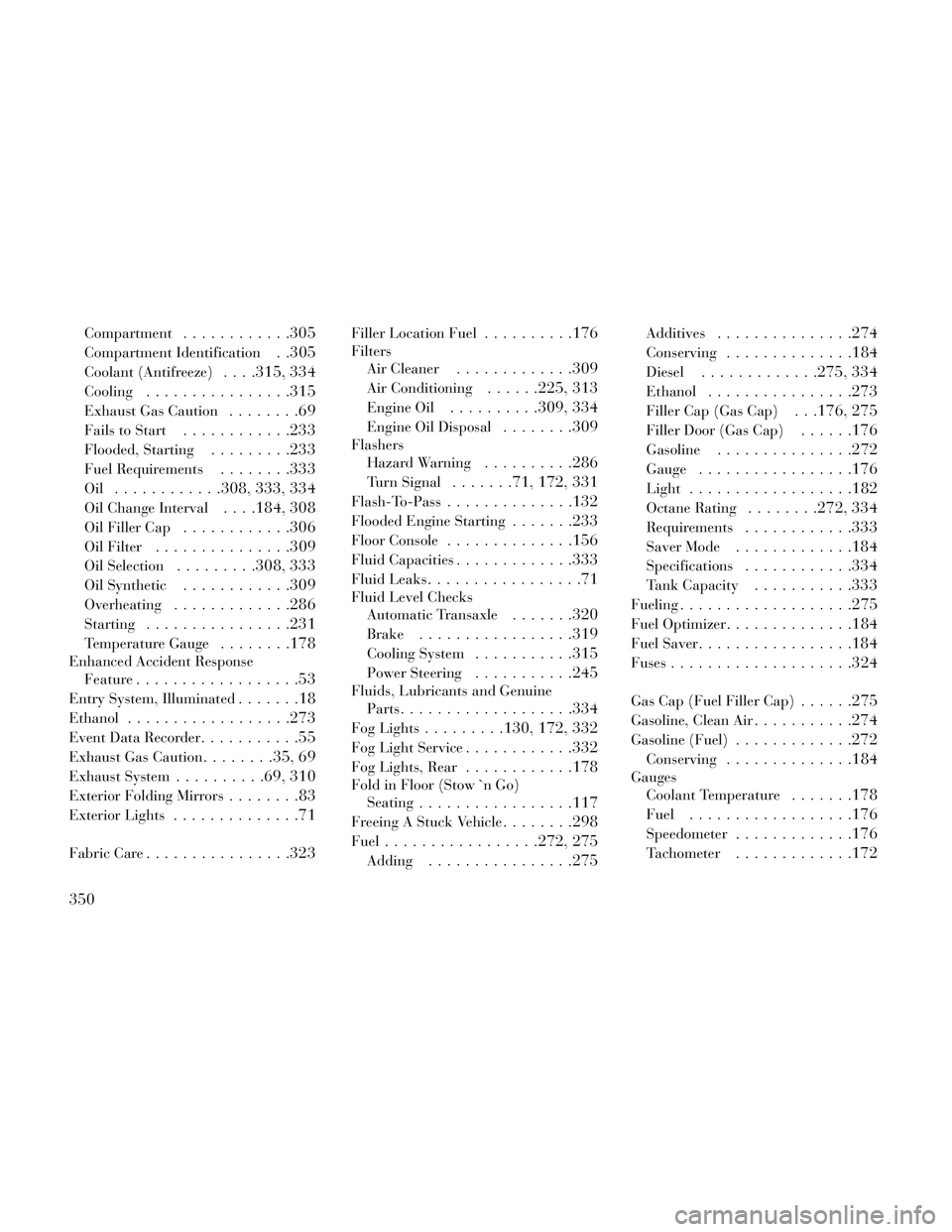
Compartment............305
Compartment Identification. .305
Coolant (Antifreeze). . . .315, 334
Cooling................315
Exhaust Gas Caution........69
Fails to Start............233
Flooded, Starting.........233
Fuel Requirements........333
Oil............308, 333, 334
Oil Change Interval. . . .184, 308
Oil Filler Cap............306
Oil Filter...............309
Oil Selection.........308, 333
Oil Synthetic............309
Overheating.............286
Starting................231
Temperature Gauge........178
Enhanced Accident Response
Feature
..................53
Entry System, Illuminated.......18
Ethanol..................273
Event Data Recorder...........55
Exhaust Gas Caution........35, 69
Exhaust System..........69, 310
Exterior Folding Mirrors........83
Exterior Lights..............71
Fabric Care................323
Filler Location Fuel..........176
FiltersAir Cleaner
.............309
Air Conditioning......225, 313
Engine Oil..........309, 334
Engine Oil Disposal........309
FlashersHazard Warning
..........286
Turn Signal.......71, 172, 331
Flash-To-Pass............. .132
Flooded Engine Starting.......233
Floor Console..............156
Fluid Capacities.............333
Fluid Leaks.................71
Fluid Level Checks
Automatic Transaxle
.......320
Brake.................319
Cooling System...........315
Power Steering...........245
Fluids, Lubricants and GenuineParts
.................. .334
Fog Lights.........130, 172, 332
Fog Light Service............332
Fog Lights, Rear............178
Fold in Floor (Stow `n Go)
Seating
.................117
Freeing A Stuck Vehicle........298
Fuel.................272, 275
Adding................275
Additives.............. .274
Conserving..............184
Diesel.............275, 334
Ethanol................273
Filler Cap (Gas Cap). . .176, 275
Filler Door (Gas Cap). . . . . .176
Gasoline.............. .272
Gauge.................176
Light................. .182
Octane Rating........272, 334
Requirements............333
Saver Mode.............184
Specifications............334
Tank Capacity...........333
Fueling.................. .275
Fuel Optimizer..............184
Fuel Saver.................184
Fuses................... .324
Gas Cap (Fuel Filler Cap)......275
Gasoline, Clean Air...........274
Gasoline (Fuel).............272
Conserving..............184
Gauges
Coolant Temperature
.......178
Fuel..................176
Speedometer.............176
Tachometer.............172
350